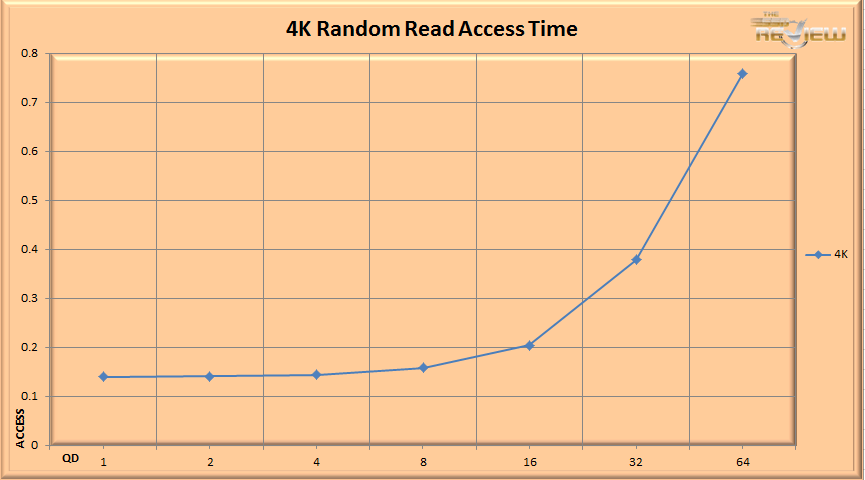FOB READ MEASUREMENTS
First we will take a look at a few key measurements that will not change over the course of time with regards to Steady State. Read-only performance shows only slight variations in regards to Steady State testing, but also can be a very good indication of the base performance of the SSD.
SSDs are all about latency, so it is a fundamental requirement to take a look at the base latency of the device. The base latency consists of the 4k Random Read speed at a Queue Depth (QD) of 1. The Toshiba comes in very well with a average latency of .14 at the lower QD, and the latency scales nicely up to the higher 32 QD range. It does shoot up quite a bit at QD64, but usually devices are limited to QD 32 or under in use.
 The 4K Random Read performance also exhibits the scaling of the device and how many IOPS it can push under desirable conditions. Here we can observe the device maxing out around 91,000 IOPS, just above the 90,000 rated IOPS.
The 4K Random Read performance also exhibits the scaling of the device and how many IOPS it can push under desirable conditions. Here we can observe the device maxing out around 91,000 IOPS, just above the 90,000 rated IOPS.
The 128K 100% Sequential Read is also another speed that will remain largely unaffected by Steady State conditioning. Here we can see some very excellent scaling, with results topping out around 600MB/s. This is actually 100 MB/s over the rated 500 MB/s.
The Random Write speed can be very telling for performance in ‘real’ environments. Mixed Read/Write workloads can become very dependent upon the write speed that is sustainable over a period of time.
Here we also begin delving into the difference between FOB (Fresh Out of Box), Steady State, and 20% over provisioned execution. Enterprise SSDs list both FOB and Steady State performance, which is crucial considering the environments that they are deployed into.
4K again being a key metric, we conducted the testing at 3 different drive states to get a full picture of the drive under various conditions. In FOB state the SSD speeds along at 40,000 IOPS, but drops to 16,505 at a QD of 32 in Steady State. With a bit of over provisioning (OP) added the 4k Random Write speed does increase somewhat, into the 20,000 IOPS range. This is an 18 percent boost in Steady State speed at the cost of 20 percent of capacity, which is a fair trade in a heavy read/write mixed workload environment.
This drop in performance is to be expected, and comes right in line with the published specifications of the drive. The results with extra OP are also very encouraging for those leveraging heavy mixed workloads. Even with the large amount of OP that is already pre-configured into every enterprise-class SSD, this only reiterates the fact that there are still gains to be made with extra OP.
 The 128K Random Write speed also shows the random performance with much larger files. Again the marked delineation between the three profiles exists very clearly.
The 128K Random Write speed also shows the random performance with much larger files. Again the marked delineation between the three profiles exists very clearly.
 The SSD Review The Worlds Dedicated SSD Education and Review Resource |
The SSD Review The Worlds Dedicated SSD Education and Review Resource | 
Thanks for the detailed report. Can you compare/contrast this with the OWC enterprise drive, which is 1700 vs 6000 for the Toshiba. Is it worth 3 times the price? I do see the attention they paid to heat and don’t know if OWC has done the same homework, but the OWC drive does use an enterprise SandForce chip which should have the same features as the Marvell.
Awaiting arrival of the OWC SSD.
I guess the price difference is SLC vs eMLC, (correct me if I’m wrong) and their additional work on putting it together really well in terms of the heat dissipation. But in real terms I guess this comes down to longevity? It would be very interesting if you could do some applied but theoretical analysis of longevity comparisons. For example, if serving a database or web server with x writes and y reads per day how long would each last? I think the SLC is in the millions so that can be counted on for 5 yrs+ but the question is, with the features of the enterprise SF chip, what life can be expected there? The speed should be comparable, maybe with a slight bump for this drive in IOPS.